Rhythmic gymnastics is women's sport based on the performance of gymnastic and dancing exercises without apparatus, as well as with the rope, hoop, ball, clubs and ribbon.
Conditions for the emergence of rhythmic gymnastics were created at the turn of 19th−20th centuries. A number of basic ideas and principles of gymnastics was formulated by French singer, teacher and theorist of stage art François Delsarte.
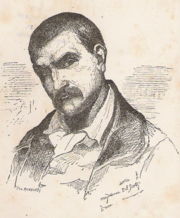 François Delsarte. Source: http://www.delsarteproject.com
François Delsarte. Source: http://www.delsarteproject.com
In the second half of the 19th century French physiologist and teacher Georges Demeny created a special system of physical exercises aimed at strengthening women's health and body, development of grace and elegance, ability to move gracefully and smoothly.
The author of "women's functional gymnastics" was a follower of Georges Demeny, gynecologist from USA Bess Mensendieck.
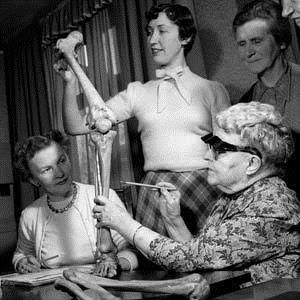 Bess Mensendieck. Source: https://www.movementhealth.com.au
Bess Mensendieck. Source: https://www.movementhealth.com.au
Professor of Geneva Conservatory Émile Jaques-Dalcroze (Emile Jaques-Dalcroze) was the Mensendieck’s system follower. The famous American dancer of the early 20th century, Isadora Duncan, significantly influenced on the formation of rhythmic direction in choreography. Her dances were based on simple movements, built on the transmission of the content of music.
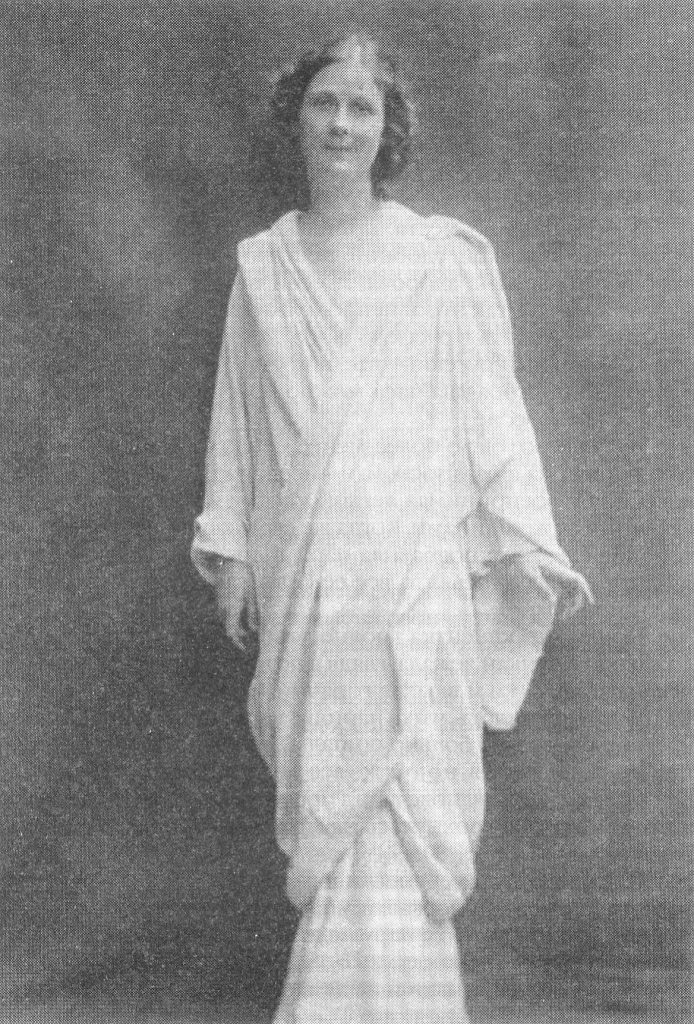 Life is like a pendulum: the deeper the sorrow, the more colorful the joy (Isadora Duncan). Source: “Ajsedora Dunkan: modern na bosu nogu”.
Life is like a pendulum: the deeper the sorrow, the more colorful the joy (Isadora Duncan). Source: “Ajsedora Dunkan: modern na bosu nogu”.
In the early 20th century St. Petersburg was one of the pivot of development of plastic art and theater. The city was established and operated a number of schools and sections: rhythmic gymnastics by Prince Sergei Volkonsky; plastic school and stage expressiveness by Claudia Isachenko-Sokolova; studio "Geptahor" at the Institute of the living word, and others. In 1920, the Petrograd Institute of the Rhythm was established etc.
In 1934 at the State Lesgaft National State University of Physical Education opened High School of Art Movement. Its first graduates were Tatiana Varakina, Anna Larionova, Tatyana Markova, Sofia Nechayeva, Julia Shishkaryova, who became later the pride of the Soviet school of rhythmic gymnastics.
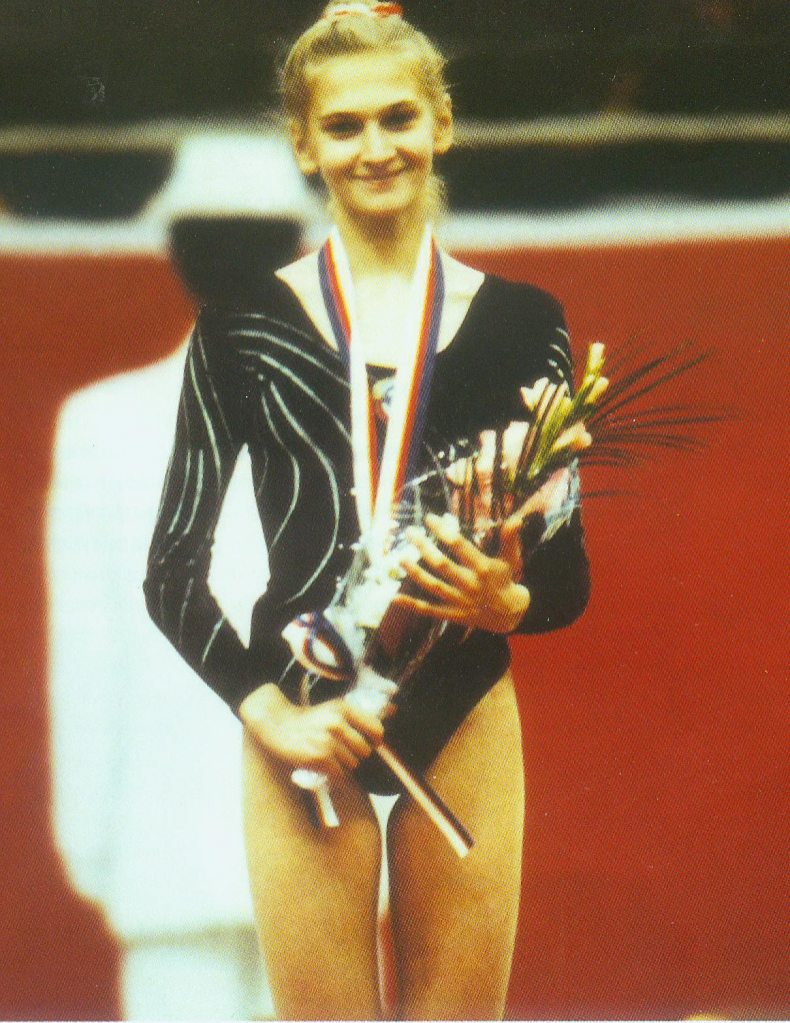 Marina Lobach, Olympic Champion (1988). Source: «Allo, MTS» magazine
Marina Lobach, Olympic Champion (1988). Source: «Allo, MTS» magazine
In April of 1941 by the forces of graduates and teachers of the High School the first Leningrad championship in rhythmic gymnastics was held. The first postwar individual and team competitions were held in Leningrad in 1946, the first USSR championship took part in 1948. By the beginning of 1960s the International Gymnastics Federation has recognized Rhythmic gymnastics as independent sport. The first official international competitions, the European Cup, was held in Budapest in December 1963. The absolute champion of the tournament and the first rhythmic gymnastics champion was Lyudmila Savinkova (USSR).
In 1980 the International Olympic Committee (IOC) includes artistic gymnastics in the Olympics programme. The first Olympic medals were played out at 1984 Summer Olympics. The first Olympic champion was Lori Fung, representative from Canada. At the 1988 Summer Olympics in Seoul, the first and last Olympic gold medal for the USSR team was won by the Belarusian athlete Marina Lobach.
The first section of rhythmic gymnastics were held in 1946 in the Vitebsk College of Physical Education. College graduates represented Belarus at the first All Union Contest in Tallinn in 1947. The first BSSR championship was held in 1951. The first champion of the country was Nina Korzhel (Mushnitskaya).
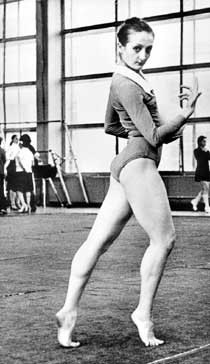 Gslina Krylenko (1970s). Source: https://www.sb.by
Gslina Krylenko (1970s). Source: https://www.sb.by
In 1978 the first specialized school in rhythmic gymnastics in the USSR was opened in Minsk, it was headed by Larisa Godieva. She trained a lot of talented gymnasts and created a Belarusian school of gymnastics, one of the strongest in the Soviet Union. Larisa Godieva is Honored Master of Sports, Honored coach of the BSSR and the USSR, Chairman of the Federation of Rhythmic Gymnastics of the USSR. The international tournament in memory of Larissa Godieva is held annually in Minsk, the Minsk City Sports School of Trade Unions was named after her.
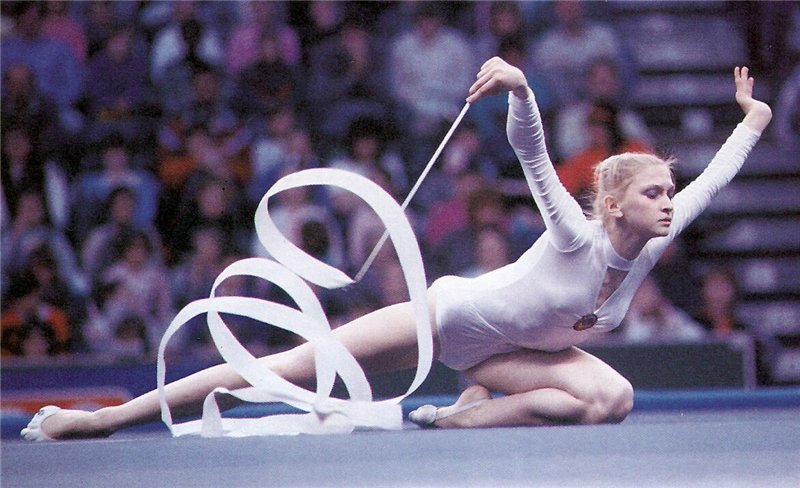 Marina Lobach, Olympic champion (1988). Source: https://by.tribuna.com
Marina Lobach, Olympic champion (1988). Source: https://by.tribuna.com
The Larissa Godieva’s trainee Galina Loginova (Krylenko) achieved considerable success, as part of the USSR team she became twice world champion (1973, 1977), in 1975−1977 she was the USSR champion, she became the Honored Master of Sports. The Galina Krylenko’s trainee Marina Lobach became the Olympic champion in 1988.
Belarusian national team in rhythmic gymnastics is one of the strongest teams in the world. Larisa Lukyanenko became five-time world champion during 1992−1996, Tatyana Ogryzko became the champion and bronze medalist of the World Championship in 1993, Evgeniya Pavlina won twice silver (1997, 1999) and bronze (1996, 1999) medals at the World championships, was the champion of Europe (1998). In 1998 the world champions in the group competitions were Olga Zaitseva, Galina Malashenko, Anna Glazkova, Tatyana Belan, Irina Ilyenkova and Anastasia Zvariko.
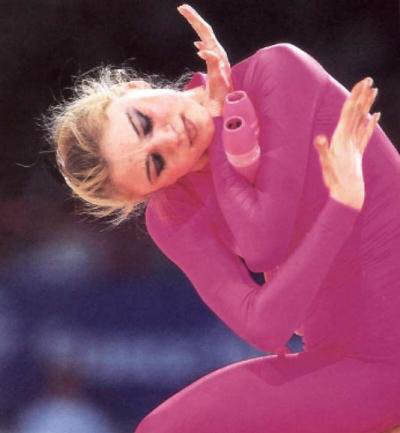 Larisa Lukyanenko, five-time world champion. Source: https://gimnastika.pro
Larisa Lukyanenko, five-time world champion. Source: https://gimnastika.pro
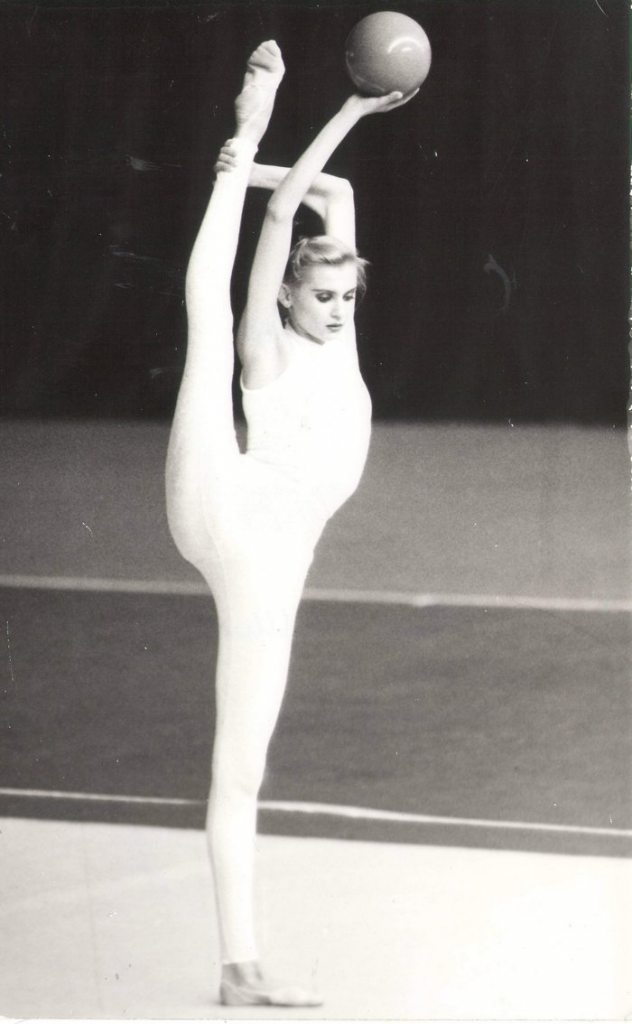 Tatyana Ogryzko, world champion. Source: https://www.pressball.by
Tatyana Ogryzko, world champion. Source: https://www.pressball.by
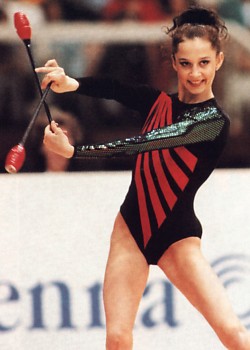 Evgenya Pavlina, medalist of the World Championships, European champion. Source: http://www.rgym.info
Evgenya Pavlina, medalist of the World Championships, European champion. Source: http://www.rgym.info
Julia Raskina from Minsk won silver medal at the 2000 Summer Olympics in Sydney. Belarusian team including Tatyana Ananko, Tatyana Belan, Anna Glazkova, Irina Ilyenkova, Maria Lazuk and Olga Puzevich won the silver medal in the group all-around.
In 2008 Inna Zhukova won the silver medal at the 2008 Summer Olympics in individual all-around competition. The team of Belarus consisting of Olesya Babushkina, Anastasia Ivankova, Ksenia Sankovich, Zinaida Lunina, Glafira Martinovic, Alina Tumilovich won the bronze medal in the group all-around competition.
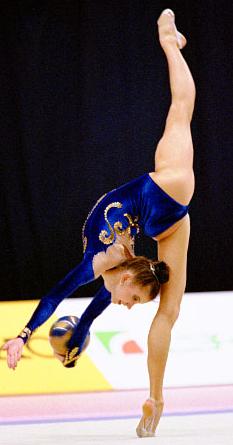 Julia Raskina, silver medalist at the 2000 Summer Olympics in Sydney. Source: https://gimnastika.pro
Julia Raskina, silver medalist at the 2000 Summer Olympics in Sydney. Source: https://gimnastika.pro
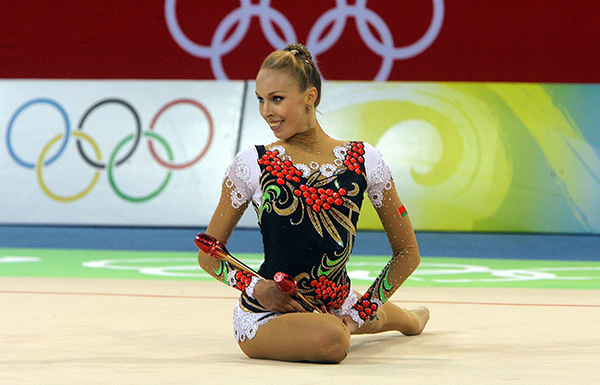 Inna Zhukova, silver medalist of the Beijing Olympics. Source: https://www.sb.by
Inna Zhukova, silver medalist of the Beijing Olympics. Source: https://www.sb.by
At the 2012 Summer Olympics in London Lyubov Cherkashina won a bronze in the individual all-around competition. Marina Goncharova, Anastasia Ivankova, Natalia Leschik, Alexandra Narkevich, Ksenia Sankovich and Alina Tumilovich won a silver at the group all-around.
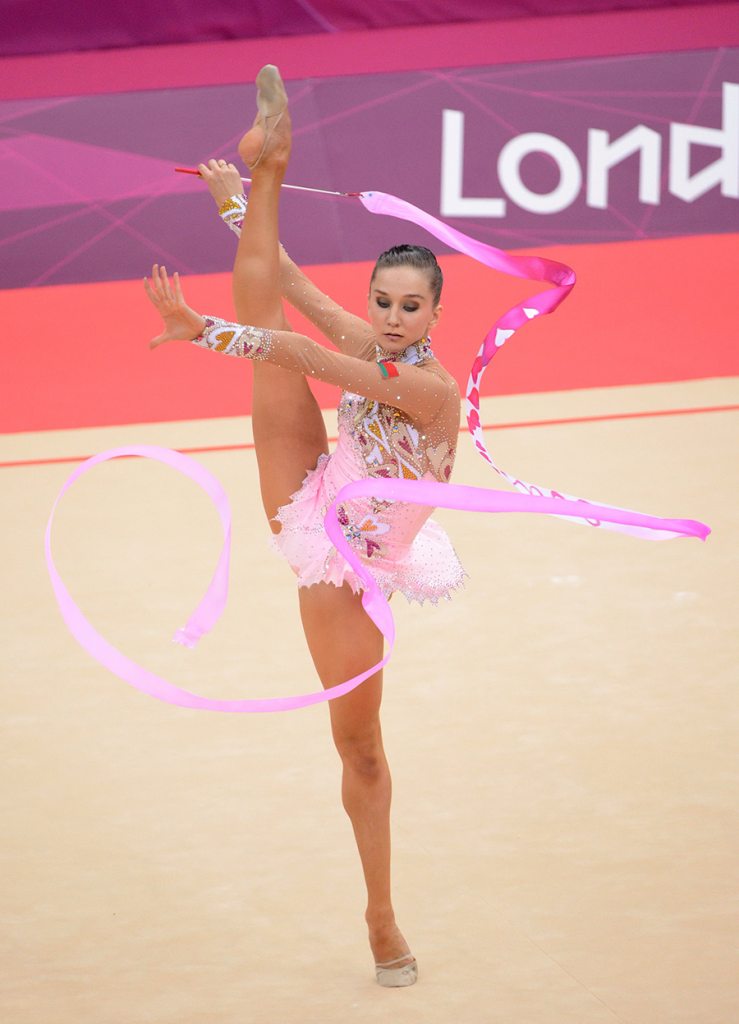 Lubov Cherkashina, bronze medalist at the London Olympics. Source: https://www.sb.by
Lubov Cherkashina, bronze medalist at the London Olympics. Source: https://www.sb.by
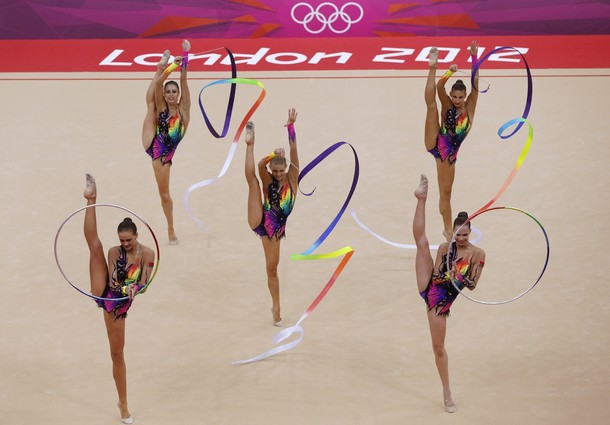 Marina Goncharova, Anastasia Ivankova, Alina Tumilovich, Ksenia Sankovich, Natalia Leschik and Alexandra Narkevich - silver (London, 2012). Source: https://www.interfax.by
Marina Goncharova, Anastasia Ivankova, Alina Tumilovich, Ksenia Sankovich, Natalia Leschik and Alexandra Narkevich - silver (London, 2012). Source: https://www.interfax.by
At the 2015 World Championship Melitina Stanyuta won bronze medals in exercises with the ball and individual all-around, which allowed our team to become silver medalists.
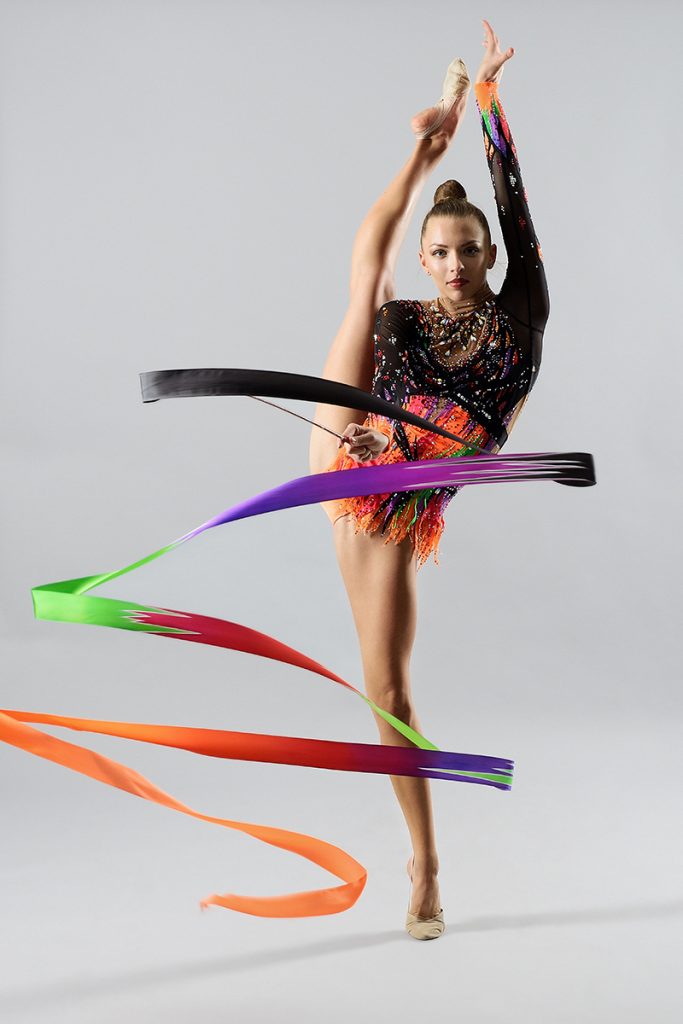 Melitina Stanyuta, bronze medalist of the 2015World Championship. Source: http://fcollection.by
Melitina Stanyuta, bronze medalist of the 2015World Championship. Source: http://fcollection.by
Belarusian athletes won 6 medals at the European Rhythmic Gymnastics Championships in 2016. The Belarusian team consisting of Ksenia Cheldyshkina, Anna Dudenkova, Maria Kadobina, Maria Kotyak, Valeria Pischelina and Arina Tsitsilina became the best in the ribbons routine and the second in all-round. Ekaterina Galkina became twice the silver medalist of the World Championships in 2017 and 2018.
Toda the National Team of Belarus in rhythmic gymnastics comprised Ekaterina Galkina, Alina Gornosko, Yulia Isachenko, Yulia Yevchik, Anna Shvayba, Margarita Ovadinskaya, Anna Gaydukevich, Anastasia Rybakova and others. In the spring of 2018 Belarusian gymnasts began to train for the 2nd European Games at the Rhythmic Gymnastics Palace.
 Logo of the Belarusian Gymnastics Association. Source: http://www.bga.by
Logo of the Belarusian Gymnastics Association. Source: http://www.bga.by
Popular organization and development of acrobatic gymnastics in the Republic of Belarus, the preparation of athletes, the organization and holding of different competitions is engaged in the public organization "Belarusian Gymnastics Association" (OO "BAG"). It brings together athletes, coaches, judges and specialists in gymnastic sports: gymnastics, rhythmic gymnastics, acrobatics, sports aerobics, trampolining and gymnastics. Official website: http://www.bga.by
Melitina Stanyuta became the record winner of medals won at the 2015 European Games in Baku in 2015. She won 4 medals: a silver for the exercise with the hoop and 3 bronze in group all-round for exercises with a ball and clubs.
Ksenia Cheldyshkina, Anna Dudenkova, Maria Kadobina, Valeria Pischelina and Arina Tsitsilina won at the group exercise with six clubs and two hoops and became bronze winners in the group all-around competition.
Champions and winners of the 2015 European Games
Literature:
- Волкова, О. А. Становление художественной гимнастики в БССР (1946―1991) / Волкова О. А. // Научное обоснование физического воспитания, спортивной тренировки и подготовки кадров по физической культуре, спорту и туризму : материалы XV Международной научной сессии по итогам НИР за 2016 год, посвященной 80-летию университета (Минск, 30 марта – 17 мая 2017 г.) : в 4 ч. / [редколлегия: Т. Д. Полякова (главный редактор) и др.]. – Минск, 2017. – Ч. 3. – С. 65–68.
- Винер-Усманова, И. А. Художественная гимнастика: история, состояние и перспективы развития : учебное пособие для образовательной программы по направлению 49.04.01 — «Физическая культура» / И. А. Винер-Усманова [и др.] ; Национальный государственный университет физической культуры, спорта и здоровья им. П. Ф. Лесгафта, Санкт-Петербург. – Москва : Человек, 2014. – С. 6–39.
Information resources:
- ОО «Белорусская ассоциация гимнастики» (БАГ) http://www.bga.by/rus/rhythmic/









